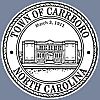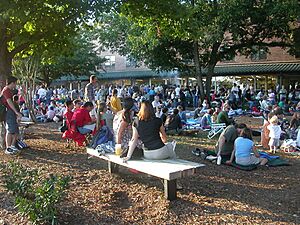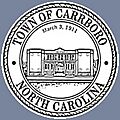Carrboro, North Carolina facts for kids
Quick facts for kids
Town of Carrboro, North Carolina
|
|||
|---|---|---|---|

The Carrboro Farmers' Market (2007)
|
|||
|
|||
| Nickname(s):
The Paris of the Piedmont, Shadow City
|
|||
| Motto(s):
"Feel Free"
|
|||

Location of Carrboro, North Carolina
|
|||
| Country | United States | ||
| State | North Carolina | ||
| County | Orange | ||
| Settled | 1882 | ||
| Incorporated | 1911 | ||
| Named for | Julian Shakespeare Carr | ||
| Government | |||
| • Type | Council–manager | ||
| Area | |||
| • Total | 6.51 sq mi (16.85 km2) | ||
| • Land | 6.47 sq mi (16.77 km2) | ||
| • Water | 0.03 sq mi (0.08 km2) | ||
| Elevation | 489 ft (149 m) | ||
| Population
(2020)
|
|||
| • Total | 21,295 | ||
| • Density | 3,288.80/sq mi (1,269.73/km2) | ||
| Time zone | UTC−5 (EST) | ||
| • Summer (DST) | UTC−4 (EDT) | ||
| ZIP code |
27510
|
||
| Area code(s) | 919 | ||
| FIPS code | 37-10620 | ||
| GNIS feature ID | 2405383 | ||
| Website | townofcarrboro.org | ||
Carrboro is a town in Orange County, North Carolina, in the United States. In 2020, about 21,295 people lived there. The town is part of the larger Research Triangle area. It was named after a North Carolina businessman named Julian S. Carr.
Carrboro is located right next to Chapel Hill. Chapel Hill is home to the main campus of the University of North Carolina. Carrboro is known for being a very open-minded community in the Southeastern United States. For example, it was the first town in North Carolina to elect a mayor who was openly gay. This happened in 1995 with Michael R. Nelson. It was also the first town in the state to offer benefits to same-sex couples.
Contents
History of Carrboro
The story of Carrboro is much like that of many mill towns in North Carolina. It is closely linked to the State University Railroad and the Alberta Cotton Mill. Carrboro was first called West End. It was settled in 1882 near a train station. This station was at the end of a 10.2-mile train track from Glenn, North Carolina.
A state law said the train station had to be at least one mile from the university. This was to stop students from leaving town too often. More people moved to West End after 1898. That's when Thomas F. Lloyd built a steam-powered mill near the station. This mill later became the Alberta Cotton Mill. In 1900, the town was briefly called Lloydville to honor him.
Julian Shakespeare Carr, a businessman from Durham, bought the mill in 1909. He added it to his chain of mills called Durham Hosiery Mills. In 1911, West End officially became a town and was named Venable. This name honored Francis Preston Venable, a chemistry professor and university president.
Just two years later, in 1913, the town was renamed Carrboro. This happened after Julian Carr brought electricity to the community. He also made the mill bigger. Besides the university and textile mills, the train station in Carrboro also helped the local wood industry. In the 1920s and 1930s, Carrboro became a major center for selling hardwood for railroad ties.
A building boom happened in Carrboro in the 1920s after a fire in the downtown area. But business at the Durham Hosiery Mills slowed down later in the decade. The Great Depression also caused economic problems. In 1930, the company closed Mill No. 4, which was the original Alberta Cotton Mill. Train service for passengers ended in 1936. In 1938, Durham Hosiery Mills closed Mill No. 7 and stopped all operations.
During World War II, Mill No. 7 was used as a factory to make weapons. After the war, Pacific Mills bought both Mill No. 4 and 7. They ran them as Carrboro Woolen Mills. Pacific Mills closed in the mid-1960s. After that, Carrboro could no longer rely on the textile industry for jobs. The University of North Carolina and other local businesses were growing fast. They offered many different types of jobs.
The mill buildings were empty for almost ten years. They were bought and sold several times. In 1975, the owner wanted to tear them down. But the community worked together to save them. They raised money and restored the buildings. Today, they are known as Carr Mill Mall.
Other important places in Carrboro are also listed on the National Register of Historic Places. These include the Carrboro Commercial Historic District, the Thomas and Mary Hogan House, and the Thomas F. Lloyd Historic District.
Geography and Climate
Carrboro is located at 35°55′14″N 79°5′2″W / 35.92056°N 79.08389°W.
The town covers about 16.8 square kilometers (6.5 square miles) in total. Most of this area, about 16.7 square kilometers (6.47 square miles), is land. A small part, about 0.08 square kilometers (0.03 square miles), is water.
Carrboro's zip code, 27510, is like an island inside Chapel Hill's 27514 zip code.
Weather in Carrboro
Carrboro usually has a humid subtropical climate. This means summers are hot and humid. Daily high temperatures are often 29°C (85°F) or higher. Winters are usually mild, with temperatures staying above freezing. Sometimes, there can be snow or ice storms.
The hottest month is July, with an average high temperature of 32°C (89°F). The coldest month is January, with an average high temperature of 9°C (49°F). The amount of rain each month is usually between 8.1 cm (3.2 inches) and 11.4 cm (4.5 inches). The most rain falls during the summer.
| Climate data for Carrboro, North Carolina | |||||||||||||
|---|---|---|---|---|---|---|---|---|---|---|---|---|---|
| Month | Jan | Feb | Mar | Apr | May | Jun | Jul | Aug | Sep | Oct | Nov | Dec | Year |
| Mean daily maximum °F (°C) | 49 (9) |
52 (11) |
62 (17) |
71 (22) |
78 (26) |
85 (29) |
89 (32) |
87 (31) |
82 (28) |
72 (22) |
63 (17) |
53 (12) |
70 (21) |
| Mean daily minimum °F (°C) | 26 (−3) |
28 (−2) |
36 (2) |
44 (7) |
53 (12) |
61 (16) |
65 (18) |
64 (18) |
57 (14) |
45 (7) |
37 (3) |
29 (−2) |
45 (8) |
| Average precipitation inches (mm) | 3.7 (94) |
3.9 (99) |
4.2 (110) |
3.2 (81) |
4.5 (110) |
4.4 (110) |
4.1 (100) |
4.4 (110) |
3.2 (81) |
3.5 (89) |
3.5 (89) |
3.5 (89) |
46.0 (1,170) |
| Source: Weatherbase | |||||||||||||
People of Carrboro
| Historical population | |||
|---|---|---|---|
| Census | Pop. | %± | |
| 1920 | 1,129 | — | |
| 1930 | 1,242 | 10.0% | |
| 1940 | 1,455 | 17.1% | |
| 1950 | 1,795 | 23.4% | |
| 1960 | 1,997 | 11.3% | |
| 1970 | 5,058 | 153.3% | |
| 1980 | 7,336 | 45.0% | |
| 1990 | 12,134 | 65.4% | |
| 2000 | 16,782 | 38.3% | |
| 2010 | 19,582 | 16.7% | |
| 2020 | 21,295 | 8.7% | |
| 2021 (est.) | 21,312 | 8.8% | |
| U.S. Decennial Census | |||
2020 Census Information
| Race | Number | Percentage |
|---|---|---|
| White (non-Hispanic) | 13,238 | 62.16% |
| Black or African American (non-Hispanic) | 2,142 | 10.06% |
| Native American | 39 | 0.18% |
| Asian | 1,881 | 8.83% |
| Pacific Islander | 10 | 0.05% |
| Other/Mixed | 1,262 | 5.93% |
| Hispanic or Latino | 2,723 | 12.79% |
In 2020, there were 21,295 people living in Carrboro. There were 9,358 households and 4,640 families.
2010 Census Information
In 2010, Carrboro had 19,582 people. There were 8,625 households and 4,020 families. The town had about 3,019 people per square mile. There were 9,258 housing units.
The town's population was made up of different groups: 70.9% White, 10.1% African American, 0.4% Native American, and 8.2% Asian. About 13.8% of the people were Hispanic or Latino.
About 26.2% of households had children under 18. About 34.5% of households were married couples. The average household had 2.27 people. The average family had 3.07 people.
The population's age spread out like this: 21.5% were under 18. About 36.1% were between 25 and 44 years old. The average age was 30.1 years.
Economy in Carrboro
From 2008 to 2012, the average income for a household in Carrboro was $45,159. For a family, the average income was $73,893. The average income per person was $32,604. About 16.1% of the population lived below the poverty line. This included 21.4% of those under 18.
Diversity in Carrboro
In the early 1990s, many people from Latin American countries started moving to Carrboro. They found jobs in building and service industries. Between 1990 and 2003, the number of Hispanic people in Carrboro grew a lot. They made up 12% of the town's population.
As these new residents settled in, they brought their food and culture. Now, Carrboro has three Latino tiendas (grocery stores). Other stores, like Food Lion, also started selling more Central and South American food.
The Human Rights Center helps people from Latino, Burmese, and Karen backgrounds. In 2009, the town government agreed to adopt the Universal Declaration of Human Rights.
Like nearby Chapel Hill, finding affordable homes has become an important issue in Carrboro.
Arts and Culture in Carrboro
Fun Places to Visit
One popular spot in Carrboro is the Carrboro Farmer's Market. Here, you can find local organic fruits and vegetables. They also sell local cheeses, baked goods, and handmade crafts. The Market started in 1977. It was one of the first places where farmers could sell directly to customers. Everything sold at the Market must be grown or made within 50 miles of Carrboro.
Carrboro's restaurants and food shops are also well-known for using local food. Many students from the UNC enjoy eating in Carrboro because of its many different restaurants. In 2005, Carrboro was named one of the 100 best art towns in America.
Carrboro has two music places that host famous and local artists. The ArtsCenter has welcomed well-known folk and roots music artists. These include David Lindley and Dr. John. It also hosts international artists like Richard Thompson. The ArtsCenter also offers art and dance classes. It moved to a new location in 2023.
The Cat's Cradle has been open for over 50 years. It hosts many different national and international musicians. Famous names like Nirvana, Public Enemy, and John Mayer have played there.
The Dirty South Institute (DSI) Comedy Theater opened in 2006. It had local comedians and offered classes in improv and stand-up comedy. The DSI Comedy Theater closed in 2017. The space later reopened as the PIT Chapel Hill.
The Carrboro Historic District is north of downtown. It has unique buildings, including about 150 mill houses. These homes were built for the workers of the Alberta Cotton Mill. Many of these homes have been fixed up. Some are now lived in by students from the nearby University of North Carolina at Chapel Hill.
Yearly Events
Carrboro is famous for its Music Festival. This is a free, all-day event that celebrates local music. Over 150 acts perform at many places downtown. The festival started in 1998. In 2002, it was renamed the Carrboro Music Festival and moved to the fall to avoid the summer heat. In 2013, it became a two-day event. Carrboro also hosts the annual West End Poetry Festival. This festival brings together many local poets.
In November, Carrboro holds its yearly film festival. The Carrboro Film Festival began in 2006. It aims to show short films (20 minutes or less) made in the local area. The first year, almost 100 films were submitted. This tradition has continued. In 2013, the festival grew to two days. It now accepts films from all over North Carolina and beyond.
Carrboro also has a yearly Pride Promenade. During this event, a rainbow goat is walked to the town commons. There, people can enjoy food trucks, drag shows, and other fun activities.
Libraries in Carrboro
Carrboro has two branches of the Orange County Public Library System. These are the Carrboro Branch Library and the Carrboro Cybrary. The Carrboro Branch Library is inside McDougle Elementary and Middle School. It has books, audiobooks, movies, music CDs, and magazines. You can also use computers and the internet there.
The Carrboro Cybrary is in the Century Center downtown. It has a smaller collection of books, audiobooks, and language learning materials. It also offers computers, internet, and Wi-Fi. Residents of Orange County can use these services for free.
Sports and Recreation
Carrboro is a center for the modern hooping movement. In 2001, Vivian Spiral started hooping on the Weaver Street Market lawn during music events. Julia Hartsell joined her in 2002. Jonathan Baxter, who started the HoopPath, also lives and teaches hooping in Carrboro. The first HoopPath Retreat was held in Carrboro in 2007 and still happens every year. The Hoop Convergence, which started in 2008, is also held yearly in Carrboro. Synergy FlowArts, a company that makes hoops, was formed in 2010.
Carrboro has 11 parks. These range from large community parks to small neighborhood play areas. The Henry Anderson Community Park is 55 acres. It has lighted baseball fields, basketball courts, tennis courts, and a large dog park. It also has a fishing pond and other fun facilities.
The Adams Tract is a 27-acre forest area near the town center. It has 1.25 miles of trails for walking and hiking. The Dr. Martin Luther King Jr. Park (10.2 acres) opened in January 2020. It has a multi-purpose field, a community garden, a bicycle pump track, and play equipment.
Education in Carrboro
The Chapel Hill-Carrboro City Schools system manages public education for over 11,000 students in Carrboro and Chapel Hill. These schools are often ranked number one in North Carolina. They have high graduation rates, good test scores, and many students go on to college.
Elementary school students in Carrboro attend Carrboro Elementary, McDougle Elementary, Morris Grove Elementary, Frank Porter Graham Elementary, or Seawell Elementary. Middle school students attend Culbreth Middle, McDougle Middle, or Smith Middle. High school students living in Carrboro go to either Carrboro High School or Chapel Hill High School.
Media in Carrboro
Carrboro, along with Chapel Hill, is served by WCHL Radio (1360 AM, 97.9 FM) and its website chapelboro.com. Both towns also have the Chapel Hill News newspaper. This paper is part of the Raleigh News & Observer. The student newspaper at the University of North Carolina is The Daily Tar Heel.
In June 2004, WCOM started broadcasting at 103.5 FM in Carrboro. You can also listen to it online at wcomfm.org. WCOM is a low-power FM radio station run entirely by volunteers. It plays local music and has community news programs.
The Carrboro Citizen was a local newspaper based in Carrboro. It started in March 2007 and was published every Thursday. It was given out for free around town. The Citizen stopped publishing in October 2012.
Notable People from Carrboro
- Jonathan Byrd, a singer and songwriter
- Elizabeth 'Libba' Cotten, a folk guitarist who wrote "Freight Train"
- Whammy Douglas, a Major League Baseball player
- Jesse Kalisher, a photographer
- Anne-Claire Niver, a singer and songwriter
- Joanna Pearson, a writer of novels, poems, and short stories
- Dexter Romweber, a singer and songwriter
- Eliza McLamb, a singer and songwriter
Carrboro's Nickname
Carrboro's nickname is "The Paris of the Piedmont." This name came from a joke by a reporter named John Martin in 1970. A student named Nyle Frank planned to be crowned "King" of an "Invisible University" in Carrboro. Martin then said, "I can see it now − The Paris of the Piedmont."
Sister Cities
Carrboro has four sister cities:
 Celaya, Guanajuato, Mexico
Celaya, Guanajuato, Mexico Juventino Rosas, Guanajuato, Mexico
Juventino Rosas, Guanajuato, Mexico San Jorge, Nicaragua
San Jorge, Nicaragua Saratov, Russia
Saratov, Russia
Images for kids
See also
 In Spanish: Carrboro para niños
In Spanish: Carrboro para niños









